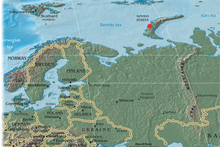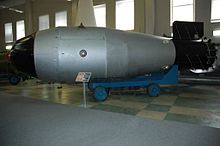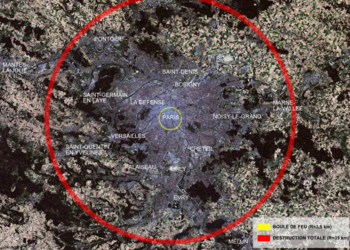
Tsar Bomba
Background Information
SOS Children has tried to make Wikipedia content more accessible by this schools selection. A good way to help other children is by sponsoring a child
| AN602 | |
|---|---|
 The Tsar Bomba mushroom cloud seen from a distance of 160 km (99.4 miles). The crown of the cloud is 56 km (34.8 miles) high at the time of the picture. |
|
| Type | Thermonuclear weapon |
| Place of origin | Soviet Union |
| Production history | |
| Designer | Julii Borisovich Khariton, Andrei Sakharov, Victor Adamsky, Yuri Babayev, Yuri Smirnov, and Yuri Trutnev |
| Number built | 1 (plus one mock bomb) |
| Specifications | |
| Weight | 27,000 kilograms (60,000 lb) |
| Length | 8 metres (26 ft) |
| Diameter | 2.1 metres (6.9 ft) |
|
|
|
| Blast yield | 57 megatons of TNT (240 PJ) (if U-238 tamper used) |
Coordinates: 73°48′26″N 54°58′54″E
Tsar Bomba (Russian: Царь-бомба; " Tsar Bomb") is the nickname for the AN602 hydrogen bomb, the most powerful nuclear weapon ever detonated. Its October 30, 1961 test remains the most powerful artificial explosion in human history. It was also referred to as Kuz'kina Mat' (Russian: Кузькина мать, Kuzka's mother), potentially referring to Nikita Khrushchev's promise to show the United States a "Kuz'kina Mat'" at the 1960 United Nations General Assembly. The famous Russian idiom, which has been problematic for translators, equates roughly with the English “We’ll show you!” Developed by the Soviet Union, the bomb was originally designed to have a yield of about 100 megatons of TNT (420 PJ), but the yield was reduced to 57 megatons to reduce nuclear fallout (and also to prevent the blast from destroying the drop aircraft). This attempt was successful, as it was one of the cleanest (relative to its yield) nuclear bombs ever detonated. Only one bomb of this type was ever officially built and it was tested on October 30, 1961, in the Novaya Zemlya archipelago, at Sukhoy Nos.
The remaining bomb casings are located at the Russian Atomic Weapon Museum, Sarov (Arzamas-16), and the Museum of Nuclear Weapons, All-Russian Research Institute of Technical Physics, Snezhinsk (Chelyabinsk-70). Neither of these casings has the same antenna configuration as the device that was tested.
Many names are attributed to the Tsar Bomba in the literature: Project 7000; product code 202 (Izdeliye 202); article designations RDS-220 (РДС-220), RDS-202 (РДС-202), RN202 (PH202), AN602 (AH602); codename Vanya; nicknames Big Ivan, Tsar Bomba, Kuz'kina Mat'. The term "Tsar Bomba" was coined in an analogy with two other massive Russian objects: the Tsar Kolokol (Tsar Bell), the world's largest bell, and the Tsar Pushka (Tsar Cannon), the world's largest cannon. The CIA denoted the test as "JOE 111".
Design
The Tsar Bomba was a three-stage Teller–Ulam design hydrogen bomb with a yield of 57 megatons (Mt). This is equivalent to 1,400 times the combined power of the bombs that destroyed Hiroshima and Nagasaki, 10 times the combined power of all the conventional explosives used in World War II, or one quarter of the estimated yield of the 1883 eruption of Krakatoa. A three-stage H-bomb uses a fission bomb primary to compress a thermonuclear secondary, as in most H-bombs, and then uses energy from the resulting explosion to compress a much larger additional thermonuclear stage. There is evidence that the Tsar Bomba had a number of third stages rather than a single very large one.
The initial three-stage design was capable of yielding the power of approximately 100 Mt, but would have caused too much radioactive fallout. To limit fallout, the third stage and possibly the second stage had a lead tamper instead of a uranium-238 fusion tamper (which greatly amplifies the reaction by fissioning uranium atoms with fast neutrons from the fusion reaction). This eliminated fast fission by the fusion-stage neutrons, so that approximately 97% of the total energy resulted from fusion alone (as such, it was one of the "cleanest" nuclear bombs ever created, generating a very low amount of fallout relative to its yield). There was a strong incentive for this modification since most of the fallout from a test of the bomb would have ended up on populated Soviet territory.
The components were designed by a team of physicists headed by Academician Yulii Borisovich Khariton and including Andrei Sakharov, Victor Adamsky, Yuri Babayev, Yuri Smirnov, and Yuri Trutnev. Shortly after the Tsar Bomba was detonated, Sakharov began speaking out against nuclear weapons, which culminated in his becoming a dissident.
Test
The Tsar Bomba was flown to its test site by a specially modified Tu-95V release plane, flown by Major Andrei Durnovtsev. Taking off from an airfield in the Kola Peninsula, the release plane was accompanied by a Tu-16 observer plane that took air samples and filmed the test. Both aircraft were painted with a special reflective white paint to limit heat damage.
The bomb, weighing 27 tonnes, was so large (8 metres (26 ft) long by 2 metres (6.6 ft) in diameter) that the Tu-95V had to have its bomb bay doors and fuselage fuel tanks removed. The bomb was attached to an 800 kilogram parachute, which gave the release and observer planes time to fly about 45 kilometres (28 mi) away from ground zero. When detonation occurred the Tu-95V fell one kilometer from its previous altitude due to the shock wave of the bomb.
The Tsar Bomba detonated at 11:32 on October 30, 1961, over the Mityushikha Bay nuclear testing range (Sukhoy Nos Zone C), north of the Arctic Circle over the Novaya Zemlya archipelago in the Arctic Sea. The bomb was dropped from an altitude of 10.5 kilometres (6.5 mi); it was designed to detonate at a height of 4 kilometres (2.5 mi) over the land surface (4.2 kilometres (2.6 mi) over sea level) by barometric sensors.
The original, November 1961 A.E.C. estimate of the yield was 55–60 Mt, but since 1991 all Russian sources have stated its yield as 50 Mt. Khrushchev warned in a filmed speech to the Supreme Soviet of the existence of a 100 Mt bomb (technically the design was capable of this yield). Although simplistic fireball calculations predicted the fireball would impact the ground, the bomb's own shock wave reflected back and prevented this. The fireball reached nearly as high as the altitude of the release plane and was seen almost 1,000 kilometres (620 mi) from ground zero. The subsequent mushroom cloud was about 64 kilometres (40 mi) high (over seven times the height of Mount Everest), which meant that the cloud was above the stratosphere and well inside the mesosphere when it peaked. The base of the cloud was 40 kilometres (25 mi) wide. All buildings in the village of Severny (both wooden and brick), located 55 kilometres (34 mi) from ground zero within the Sukhoy Nos test range, were destroyed. In districts hundreds of kilometers from ground zero wooden houses were destroyed, stone ones lost their roofs, windows and doors; and radio communications were interrupted for almost one hour. One participant in the test saw a bright flash through dark goggles and felt the effects of a thermal pulse even at a distance of 270 kilometres (170 mi). The heat from the explosion could have caused third-degree burns 100 km (62 mi) away from ground zero. A shock wave was observed in the air at Dikson settlement 700 kilometres (430 mi) away; windowpanes were partially broken to distances of 900 kilometres (560 mi). Atmospheric focusing caused blast damage at even greater distances, breaking windows in Norway and Finland. The seismic shock created by the detonation was measurable even on its third passage around the Earth. Its seismic body wave magnitude was about 5 to 5.25. The energy yield was around 8.1 on the Richter scale but, since the bomb was detonated in air rather than underground, most of the energy was not converted to seismic waves. The TNT equivalent of the 50 Mt test could be represented by a cube of TNT 312 meters (1023 feet) on a side, approximately the height of the Eiffel Tower.
Analysis
The Tsar Bomba is the single most physically powerful device ever used by man. By contrast, the largest weapon ever produced by the United States, the now-decommissioned B41, had a predicted maximum yield of 25 Mt, and the largest nuclear device ever tested by the United States ( Castle Bravo) yielded 15 Mt (this was due to an unexpected runaway lithium-7 reaction; the design yield was approximately 5 Mt). The largest weapons deployed by the Soviet Union were also around 25 Mt, as in the SS-18 Mod. 2 ICBM warheads.
The weight and size of the Tsar Bomba limited the range and speed of the specially modified bomber carrying it and ruled out its delivery by an ICBM (although on December 24, 1962, a 50 Mt ICBM warhead developed by Chelyabinsk-70 was detonated at 24.2 Mt to reduce fallout). Much of its high-yield destructiveness was inefficiently radiated upwards into space. It has been estimated that detonating the original 100 Mt design would have released fallout amounting to about 25 percent of all fallout emitted since the invention of nuclear weapons. Hence, the Tsar Bomba was an impractically powerful weapon. It was decided that a full 100 Mt detonation would create too great a risk of nuclear fallout, as well as a near certainty that the release plane (and crew) would be destroyed before it could escape the blast radius.
The Tsar Bomba was the culmination of a series of high-yield thermonuclear weapons designed by the Soviet Union and the United States during the 1950s (examples include the Mark-17 and B41). Such bombs were designed because:
- The nuclear bombs of the day were large and heavy, regardless of yield, and could only be delivered by strategic bombers. Hence yield was subject to dramatic economies of scale;
- It was feared that many bombers would fail to reach their targets because their size and low speed made detection and interception easy. Hence maximizing the firepower carried by any single bomber was considered vital;
- Before satellite intelligence each side lacked precise knowledge of the location of the other's military and industrial facilities;
- A bomb dropped without benefit of advanced inertial navigation systems could easily miss its intended target. Parachute retardation would only worsen the bomb's accuracy.
Thus certain bombs were designed to destroy an entire large city even if dropped five to ten kilometers from its centre. This objective meant that yield and effectiveness were positively correlated, at least up to a point. However, the advent of ICBMs accurate to 500 meters or better made such yields unnecessary. Subsequent nuclear weapon design in the 1960s and 1970s focused primarily on increased accuracy, miniaturization, and safety. The standard practice for many years has been to employ multiple smaller warheads ( MIRVs) to " carpet" an area, resulting in greater ground damage.
Films
- Footage from a Soviet documentary about the bomb is featured in Trinity and Beyond: The Atomic Bomb Movie (Visual Concept Entertainment, 1995), where it is referred to as the Russian monster bomb. The movie states that the Tsar Bomba project broke the voluntary moratorium on nuclear tests. In fact Soviets restarted their tests and broke the unilateral voluntary moratorium two months before Tsar Bomba, and since the moratorium was unilateral there was no multilateral legal obstacle (earlier the U.S. also declared a one year unilateral moratorium on nuclear tests and as that year expired the US had already announced that it considered itself free to resume testing without further notice but had not resumed tests until the aftermath of Tsar Bomba).
- A one hour episode of the PBS documentary series Secrets of the Dead – "World's Biggest Bomb" (2011; Blink Films & WNET) – chronicles the events leading to the detonations of Castle Bravo and the Tsar Bomba.




